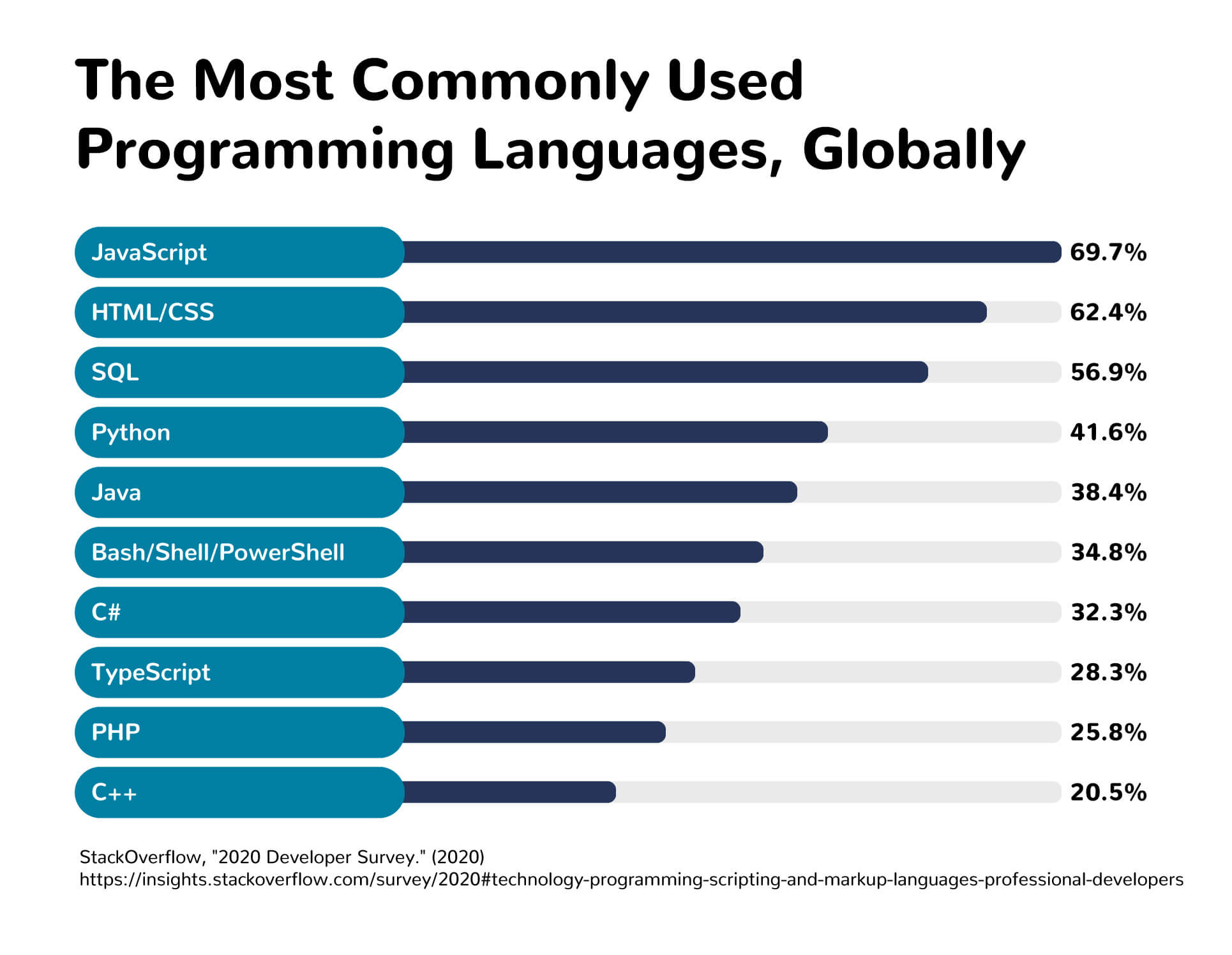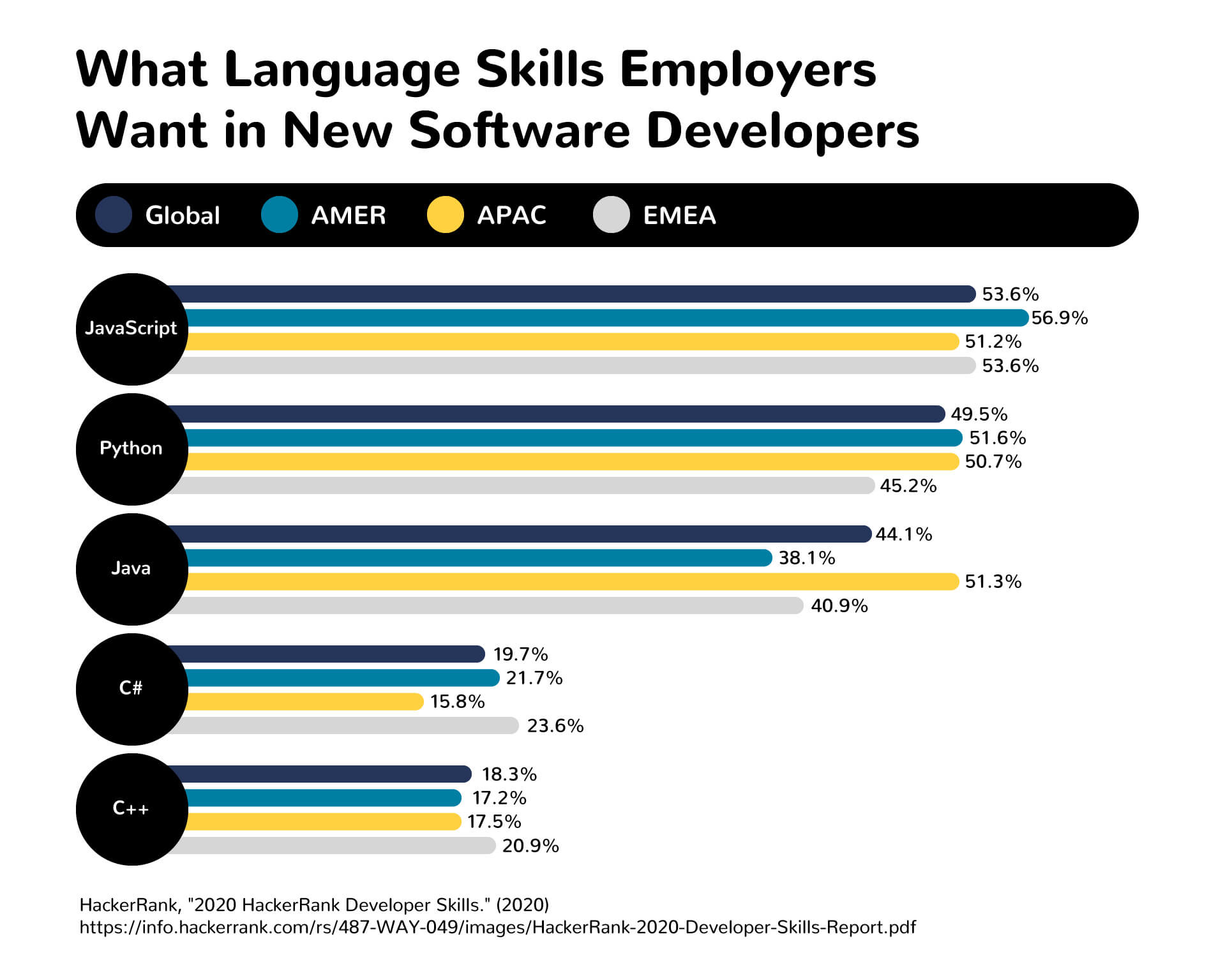In-Demand Software Developer Skills

While not all software developers can shift seamlessly between different programming languages, that doesn’t mean they aren’t multilingual to some degree. Talented software developers are almost always fluent in a swath of programming dialects and technologies. For any aspiring dev, the learning opportunities are nearly endless.
But, given the sheer volume of open-source knowledge out there, new learners might wonder: Which software developer skill sets should I prioritize?
Yes, it’s an intimidating question — but don’t fret! In this article, we’ll outline which software developer skills you’ll need to master to land an entry-level job, which skills will help you advance to senior roles, and which ones simply aren’t worth your time.
Let’s get started!
Industry Trends
First off, it’s important to note that not all programming languages are created equal. Some are trendy, but doomed to fall out of style in a year or two; others are universally hated, but used in perpetuity. Still more are frequently used for one niche coding application, but barely touched beyond it.
You might want to consider a coding boot camp to become proficient in the most in-demand full stack programming languages in 12 or 24 weeks.
It can be daunting for new or aspiring developers to figure out which languages employers care the most about — but the truth is, selecting the right language is one of the most important inroads to landing a fulfilling role.
Make sure to consider these key questions:
- What languages are most commonly used in production environments?
- Which ones are seldom used?
- Which languages correlate to higher pay?
Note that while following industry trends aren’t always a surefire bet for picking the most lucrative, in-demand language, they should help you at least shortlist your options.
For now, let’s consider the current trends in the most popular software developer skills.
According to Stack Overflow’s 2020 developer study, JavaScript currently reigns supreme as the most commonly used language in the world (69.7 percent), followed by HTML/CSS (62.4 percent), SQL (56.9 percent), Python (41.6 percent), and Java (38.4 percent).
 Why does this matter? As a rule of thumb, the more common a language is, the more likely it is that you will encounter it at work and, thus, need to know it. That said, popularity isn’t the only metric you should pay attention to. Trends will differ among individual developers, employers, and industries.
Why does this matter? As a rule of thumb, the more common a language is, the more likely it is that you will encounter it at work and, thus, need to know it. That said, popularity isn’t the only metric you should pay attention to. Trends will differ among individual developers, employers, and industries.
Consider the financial tech world, which overwhelmingly relies on COBOL (the Common Business-Oriented Language). After falling into relative obscurity in the 1960s, COBOL returned with force: now, the language powers 70 to 80 percent of business transactions worldwide.
Yes, you read that right: a language largely ignored by or utterly unknown to most programmers comprises 220 billion lines of in-person financial transactions today.
But let’s put that aside for a moment and consider the languages that developers are interested in learning. By factoring in these trends, you’ll gain a clearer picture of which languages, like COBOL, may see a resurgence in popularity in the not-too-distant future. Employers love job candidates who can think ahead of the curve.
One Stack Overflow study surveyed developers on their interests. They found that the languages most-loved by programmers in 2020 included Rust (86.1 percent), TypeScript (67.1 percent), Python (66.7 percent), Kotlin (62.9 percent), and Go (62.3 percent). The most-wanted languages included Python (30 percent), JavaScript (18.5 percent), Go (17.9 percent), and TypeScript (17 percent).
Now that we have a general handle on which languages are commonly used and popular, let’s determine which software developer skill set you’ll need to learn first.
The Software Development Skills to Learn First
No matter the industry you break into, it is mission-critical to develop a robust, theoretically backed foundation of skills that employers want. Luckily, there is ample data reflecting the most current employer hiring trends.
According to HackerRank’s 2020 Developer survey (PDF, 2.4 MB), the languages that most hiring managers globally seek out include JavaScript, Python, Java, and C#.

To reiterate: it is best to focus on developing the most commonly used and industry-applicable skills. Don’t worry if you’re missing a few of the bunch, though; for many hiring managers, language isn’t the end-all-be-all in applicant selection. In fact, 21 percent of hiring managers are language agnostic when screening candidates.
Keeping all of this in mind, let’s go over the software developer skills that new learners should prioritize.
Skills to Learn
For each skill below, we’ll provide a brief overview of its use cases and foundational characteristics. Make sure to reference the included links to gain a better understanding of the languages.
HTML & CSS
HTML, or HyperText Markup Language, forms the backbone of the web, defining the structure and layout of webpages through files with an “.html” extension. All elements on a page are described through closing and opening tags, which dictate where features such as paragraphs, bold text, containers, page links, and buttons go.
If HTML defines a page’s basic anatomy, CSS (Cascading Style Sheets) determines how the elements that make up a website’s “skeleton” look. Developers use CSS tag selectors that uniquely identify HTML elements by name to apply styling. Colors, positioning, shadows, box radii, and even limited-function animations are all defined by CSS.
JavaScript
JavaScript is a high-level scripting language that allows developers to insert dynamic functionality into a webpage. With JavaScript, HTML elements are no longer static — a webpage can respond to a user’s behavior.
Animations, interactive maps, time-based page updates, and 2D/3D graphics all fall under the purview of JavaScript. The language exposes all this functionality through event listeners, which use specific cues, like button clicks or mouse movement, to prompt a response — say, a video ad or a drop-down menu.
The flexible language can be customized and extended through open-source libraries, packages, or custom code modules created by other developers. Many companies provide APIs (Application Programming Interfaces) that allow developers to interact with huge codebases and websites.
Python
Python was first created to automate scripts and empower developers to rapidly prototype applications. In recent years, Python has risen to prominence as one of the world’s predominant coding languages.
Like JavaScript, Python is a scripting language that makes it easy to interface with APIs and define custom and dynamic web page behavior. Python is the most popular language in the fields of data science, analytics, and machine learning.
Many software developers use Python because it is flexible and very easy to learn.
SQL & NoSQL
SQL (Structured Query Language) is a language specific to the processing, querying, and managing of databases. For newcomers, databases are simply “storage units” that permanently store information collected by a business application.
Developed in the ’70s, SQL is a table-based language that stores data points in a tabular, relational format. Technically, developers don’t use SQL itself; instead, they rely on pre-defined database solutions such as MySQL, PostgreSQL, SQLite, and Firebird. You may want to familiarize yourself with one (or more) of those products.
As you can likely imagine, NoSQL (Non-Structured Query Language) is the opposite of SQL; it allows for data to be documented in a flexible, non-tabular format. Not all documents in a pre-defined collection need to have the same fields or data types.
For instance, imagine a user profile that stores information about a user’s past romantic relationships. Not all users have had partners before, so a NoSQL database allows the field to be non-existent, while a SQL data solution would have a NULL value for the romantic partners’ field. As any day-one developer knows, this NULL value could cause headache-inducing bugs during development!
Java
No, it’s not a cup of coffee. Rather, Java is one of the most influential programming languages in use today.
Java is an object-oriented language that defines functionality and attributes in terms of pre-defined, class-categorized objects. For instance, a developer could create a Dog class with a “makeSound” method (bark) defined on it. Subclasses derived from Dog, such as GoldenRetriever or Labrador, could redefine their own “makeSound” method. This makes Java highly modular and inheritance-based.
Java is a language used for web development, analytics, device driver software, and more. Java revolutionized the concept of “writing once, running everywhere,” which allowed all code written in Java to run on any operating system.
No matter where you go or how you specialize, you’ll encounter Java at some point in your career.
Software Developer Skills for Career Advancement
While some skills may not land an entry-level position, they can prove to be incredibly advantageous down the line.
For example, those who know Perl tend to make roughly 54 percent more than the average developer (PDF, 2.4 MB), closely followed by Scala (+42 percent) and Go (+33 percent). However, it is worth noting that significantly more senior developers know these languages than their junior counterparts. Given that senior developers tend to make more money than juniors, demographics may skew the correlation between language and earnings.
Still, a junior developer who takes the initiative to learn more skills will invariably be more strongly regarded for senior positions as they open up.
Skills to Learn
Below, we’ve broken down the best skills for more advanced programmers to know.
C++
Like Java, C++ is an object-oriented programming language; however, it allows objects to be transformed in more sophisticated ways. Unlike Java, C++ is only a little removed from a ground-level computer assembly language, and requires quite a bit of hard-coding. Developers must manually allocate and deallocate memory for new objects.
The language is most commonly used in embedded systems, such as medical machines, IoT sensors, smart devices, and video games.
R
R is a package-based language primarily used for statistical computing, data analysis, and graphics. Compared to C++ and Java, R stands out for its graphics-driven statistical interface.
Developers can customize their own interfaces, interact with program elements through a visual debugger, and gain access to underlying language-defined functions stored in script files. R is an excellent choice for those who want to transfer over into data science roles.
C#
C#, or C Sharp, is an object-oriented language most often used for web development. C# is very similar to C++ but allows developers to skirt the bugs they most commonly find when developing in C++. It’s widely considered more expressive and less error-prone, allowing developers to get more done in a shorter time.
Go
Developed in 2007, Go is still in its infancy but has quickly become very popular in development circles. Although it’s similar to C, Go makes it easier to introduce concurrent solutions to multifaceted coding problems. Concurrency simply refers to the computation of several processes at the same time. The language also automatically manages memory and provides type-safe conversion, making it more efficient and less bug-prone than its predecessors.
Rust
Offered as yet another alternative to C++, Rust is an object-oriented programming language with low overhead and an ability to prototype solutions quickly. It’s held a spot on StackOverflow’s “Most Loved Languages” list for four straight years and has a reputation for being both easy-to-use and secure. As an added bonus, its statically-typed syntax makes it easy to spot errors when they occur.
Ruby
Ruby is not widely adopted by employers yet, but legions of dedicated open-source developers love it. Created to be more powerful than Perl and more object-oriented than Python, Ruby is inspired by lesser-known languages such as Lisp and Smalltalk.
In Ruby, every variable is considered an object with its own internal, encapsulated state. This isolation makes it more difficult for developers to make complex errors since objects can only be compromised through specific methods. When bugs are introduced, however, they can be quickly identified and resolved because Ruby objects are modular and isolated from one another.
The Software Development Skills to De-Prioritize
While it’s hard to qualify any particular language as “obsolete” or “unmarketable” (especially given that at least one employer in the world probably uses it), there are some that are of a lower priority than others. If languages are relatively unpopular, new learners should put them on the back burner in favor of more popular and relevant languages.
According to Stack Overflow, the dreaded trifecta of modern programming includes VBA, Objective-C, and Perl. The three are the least-used languages, with VBA just barely taking the lead at 6.2 percent regular use by devs.
Do yourself a favor and scratch those languages out of your memory — at least for now.
How to Learn the Most In-Demand Skills
Wondering how to gain the necessary software developer skill set? Thankfully, there are plenty of cost-effective routes to get the education you need to succeed.
If you have yet to pursue higher education, getting a college degree in a related field will give you the best chance of market success right out of the gate. Consider pursuing majors such as computer science, programming, information sciences, and software development.
College provides the most in-depth, conceptually backed understanding behind the fundamentals of software development. It also gives you plenty of time to develop a stand-out portfolio and make industry connections.
That said, college isn’t for everyone; after all, it’s a significant investment of time, money, and resources.
Many learners instead decide to pursue coding boot camps, which are intensive, short-term programs that equip participants with the most in-demand skills to land an entry-level job. In as little as three to six months, you can start interviewing for software development jobs.
Boot camps are a magnitude less expensive than college and allow for flexible learning schedules. Many programs can be taken online, in-person, part-time, or full-time. Still, boot camps aren’t cost-free and don’t provide quite as comprehensive an education as college does.
If structured learning isn’t your preference, or you’re particularly tight on funds, we suggest starting with a self-directed education. You can learn everything you need to through low-cost books, online courses, and tutorials. Keep in mind that self-study requires no shortage of passion, dedication, and discipline. Careless learners may end up investing their time into improperly structured or useless materials.
Make sure to consider your options, current obligations, and resources before opting for any specific learning regimen!
Additional Resources:
- UT Austin Boot Camps — University of Texas at Austin
- Learn to Code at Home — freecodecamp
- Choosing a Computer Science Major — CollegeBoard BigFuture
Without a doubt, software development is one of the most impactful and fulfilling career fields to enter today. And everyone can learn to program! Whether you’re looking to switch careers or make yourself a more marketable employee, it certainly doesn’t hurt to have a little software know-how under your belt.
Reflect on which educational option is right for you, and start acquiring the software developer skills you need to succeed.

 Live Chat
Live Chat